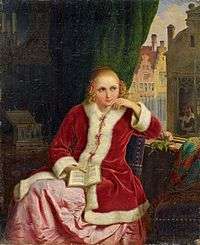Heinrich von Rustige
Heinrich Franz Gaudenz von Rustige (12 April 1810[1] – 15 January 1900) was a German painter specializing in historical subjects and genres.

Life and work
He was born in Werl. Beginning in 1828, he was a student of Wilhelm von Schadow at the Kunstakademie Düsseldorf. In 1836, he moved to Frankfurt, where he became a teacher at the Städel Institute.[2] He undertook study trips to Vienna, Dresden, Berlin, France and England. By 1845 he was at the State Academy of Fine Arts Stuttgart and an Inspector at the Württemberg Staatsgalerie. He gave up teaching in 1887.
Rustige died in Stuttgart in 1900. The largest collection of his paintings is in the Municipal Museum in Werl.
Poetry
Rustige is also known as a poet. A volume of lyrical poems in 1845 was followed by the historical verse dramas "Filippo Lippi" (1851), "Attila" (1853), "Konrad Widerhold" (1856) and "Eberhard im Bart" (1863). "Kaiser Ludwig, der Baier" (1860) has been reprinted by the Nabu Press (2012).[3] He wrote a popular military song, "Deutscher Marsch," set to music by Kücken.[2]
Major works

| Wikimedia Commons has media related to Heinrich von Rustige. |
- "Die Überschwemmung" (The Flood, National Gallery, Berlin)
- "Herzog Alba im Schloss zu Rudolstadt" (The Duke of Alva in the Castle of Rudolstadt, Galerie zu Stuttgart)
- "Überführung der Leiche Kaiser Ottos III nach Deutschland" (The Transfer of Emperor Otto III's Body to Germany, Municipal Museum Werl)
- "Friedrich II und sein Hof in Palermo" (Frederick II and his Court in Palermo, Municipal Museum Werl)
Honors
- 1867: Awarded the Knight's Cross, First Class of the Order of the Crown (Württemberg), which conferred a title of nobility.[4]
- 1890: Made an Honorary Citizen of Werl.
References
- Taufregister, St. Walburga Werl, Jg. 1810, S. 217
-

- ISBN 1-2861-0650-8
- Hof- und Staatshandbuch des Königreichs Württemberg 1894, Seite 33
Sources
- Gisela Hengstenberg: Rübezahl im Königsbau. Die Stuttgarter Künstlergesellschaft „Das Strahlende Bergwerk“, Stuttgart 2003.
- Ingeborg Krekler: Katalog der handschriftlichen Theaterbücher des ehemaligen württembergischen Hoftheaters : (codices theatrales) , Wiesbaden 1979, S. 47, 205 und 335 (Digitalisat)
- Manfred Schmid; Jutta Ronke: Städtisches Lapidarium, Museumsführer, Stuttgart 2006.
- Stuttgart, in: Deutsches Kunstblatt. Zeitschrift für bildende Kunst, Baukunst und Kunstgewerbe 2.1851, Nr. 43 vom 25. Oktober, S. 348 (Digitalisat)
- Gustav Wais: Stuttgarts Kunst- und Kulturdenkmale : 25 Bilder mit stadtgeschichtlichen, baugeschichtlichen und kunstgeschichtlichen Erläuterungen, Stuttgart [1954].
External links
- List of Authors from Westphalia, 1750 to 1950: (with references)